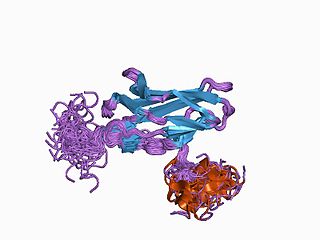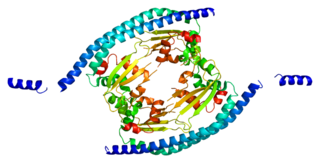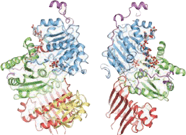This gene encodes a protein with one SAP domain. The protein binds to cruciform DNA and DNA coiled into a superhelix, thereby inducing positive supercoils into closed circular DNA. It is also involved in splice site selection during mRNA processing. Chromosomal aberrations involving this region increased expression of this gene and the presence of antibodies against this protein are all associated with various diseases. [6]

Acute myeloblastic leukemia with maturation (M2) is a subtype of acute myeloid leukemia (AML).

ETV6 protein is a transcription factor that in humans is encoded by the ETV6 gene. The ETV6 protein regulates the development and growth of diverse cell types, particularly those of hematological tissues. However, its gene, ETV6 frequently suffers various mutations that lead to an array of potentially lethal cancers, i.e., ETV6 is a clinically significant proto-oncogene in that it can fuse with other genes to drive the development and/or progression of certain cancers. However, ETV6 is also an anti-oncogene or tumor suppressor gene in that mutations in it that encode for a truncated and therefore inactive protein are also associated with certain types of cancers.

T-cell acute lymphocytic leukemia protein 1 is a protein that in humans is encoded by the TAL1 gene.

Runt-related transcription factor 1 (RUNX1) also known as acute myeloid leukemia 1 protein (AML1) or core-binding factor subunit alpha-2 (CBFA2) is a protein that in humans is encoded by the RUNX1 gene.

MN1 is a gene found on human chromosome 22, with gene map locus 22q12.3-qter. Its official full name is meningioma 1 because it is disrupted by a balanced translocation (4;22) in a meningioma.

Zinc finger and BTB domain-containing protein 16 is a protein that in humans is encoded by the ZBTB16 gene.

Homeobox protein Hox-A9 is a protein that in humans is encoded by the HOXA9 gene.

Core-binding factor subunit beta is a protein that in humans is encoded by the CBFB gene.

Protein CBFA2T1 is a protein that in humans is encoded by the RUNX1T1 gene.

Protein SET, also known as Protein SET 1, is a protein that in humans is encoded by the SET gene.

Nucleoporin 214 (Nup2014) is a protein that in humans is encoded by the NUP214 gene.

ERG is an oncogene. ERG is a member of the ETS family of transcription factors. The ERG gene encodes for a protein, also called ERG, that functions as a transcriptional regulator. Genes in the ETS family regulate embryonic development, cell proliferation, differentiation, angiogenesis, inflammation, and apoptosis.

K(lysine) acetyltransferase 6A (KAT6A), is an enzyme that, in humans, is encoded by the KAT6A gene. This gene is located on human chromosome 8, band 8p11.21.

Protein AF-10 is a protein that in humans is encoded by the MLLT10 gene.

Protein CBFA2T3 is a protein that in humans is encoded by the CBFA2T3 gene.

Protein ENL is a protein that in humans is encoded by the MLLT1 gene.

Pre-B-cell leukemia transcription factor 3 is a protein that in humans is encoded by the PBX3 gene.

Myeloid leukemia factor 1 is a protein that in humans is encoded by the MLF1 gene.

T-cell acute lymphocytic leukemia 2, also known as TAL2, is a protein which in humans is encoded by the TAL2 gene.

An exon junction complex (EJC) is a protein complex which forms on a pre-messenger RNA strand at the junction of two exons which have been joined together during RNA splicing. The EJC has major influences on translation, surveillance and localization of the spliced mRNA. It is first deposited onto mRNA during splicing and is then transported into the cytoplasm. There it plays a major role in post-transcriptional regulation of mRNA. It is believed that exon junction complexes provide a position-specific memory of the splicing event. The EJC consists of a stable heterotetramer core, which serves as a binding platform for other factors necessary for the mRNA pathway. The core of the EJC contains the protein eukaryotic initiation factor 4A-III bound to an adenosine triphosphate (ATP) analog, as well as the additional proteins Magoh and Y14. The binding of these proteins to nuclear speckled domains has been measured recently and it may be regulated by PI3K/AKT/mTOR signaling pathways. In order for the binding of the complex to the mRNA to occur, the eIF4AIII factor is inhibited, stopping the hydrolysis of ATP. This recognizes EJC as an ATP dependent complex. EJC also interacts with a large number of additional proteins; most notably SR proteins. These interactions are suggested to be important for mRNA compaction. The role of EJC in mRNA export is controversial.